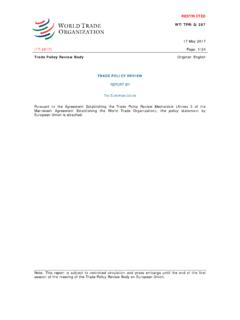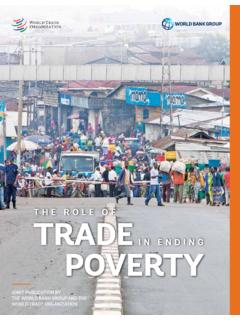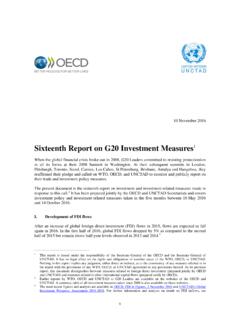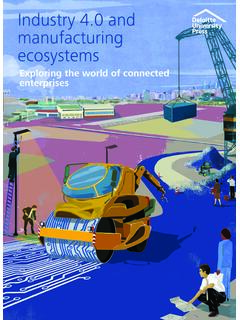Transcription of C. Fundamental economic factors affecting international trade
1 World trade report 2013112 The previous section has shown that the future of trade and economic growth depends on a range of factors . Predictions may change depending on how each of these factors develops. This section discusses how the Fundamental economic factors shaping the future of international trade namely demography, investment, technology, energy and other natural resources, transportation costs and the institutional framework are likely to evolve in the coming years. C. Fundamental economic factors affecting international tradeII factors shapIng the Future oF world trade113fifi fi fi fi fi Contents 1 Demographic change 114 2 Investment 134 3 Technology 152 4 Energy and other natural resources 166 5 Transportation costs 179 6 Institutions 192 7 Conclusions 207 Appendix 217 Some key facts and findings Demographic change affects trade through its impact on countries comparative advantage and on import demand.
2 An ageing population, migration, educational improvements and women s participation in the labour force will all play a role in years to come, as will the continuing emergence of a global middle class. Investment in physical infrastructure can facilitate the integration of new players into international supply chains. The accumulation of capital and the build-up of knowledge and technology associated with investment, particularly foreign direct investment, can also enable countries to move up the value chain by altering their comparative advantage. New players have emerged among the countries driving technological progress. Countries representing 20 per cent of the world s total population accounted for about 70 per cent of research and development (R&D) expenditure in 1999, but only about 40 per cent in 2010.
3 Technology spillovers are largely regional and stronger among countries connected by production networks. In addition to the traditionally R&D intensive manufacturing sectors, knowledge-intensive business services are emerging as key drivers of knowledge accumulation. The shale gas revolution portends dramatic shifts in the future pattern of energy production and trade as North America becomes energy sufficient. Increasing water scarcity in the future in large swathes of the developing world may mean that the long-term decline in the share of food and agricultural products in international trade might be arrested or even reversed. Ample opportunities exist for policy actions, at the national and multilateral level, to reduce transportation costs and offset the effect of higher fuel costs in the future improving the quantity and quality of transportation infrastructure, successfully concluding the Doha Round negotiations on trade facilitation, introducing more competition on transport routes, and supporting innovation.
4 Improvements in institutional quality, notably in relation to contract enforcement, can reduce the costs of trade . Institutions are also a source of comparative advantage, and trade and institutions strongly influence each trade report 2013114 Various economic theories use Fundamental economic factors to explain why countries trade and how trade patterns evolve. In David Ricardo s theory, for instance, technological differences between countries determine comparative advantage. In the Heckscher-Ohlin model, relative factor endowments (labour, capital and natural resources) shape trade patterns. The new trade theory predicts that countries with larger economies as a result of growth in endowments and incomes will develop an export edge in those goods consumed in relatively greater quantities in the home market.
5 The new new trade theory identifies trade costs as a key impediment to entry into trade . Others argue that the quality of a country s political and economic institutions can be a key source of comparative advantage. This section also covers feedback effects from trade which, in turn, have an impact on the Fundamental economic factors shaping trade . trade can lead to technological spillovers, for example, allowing countries with less technological expertise to acquire much-needed know-how. Engaging in trade can also help to strengthen political and economic section shows how developments in demography, investment, technology, energy and other natural resources, transport costs and institutional quality are capable of changing the overall nature of trade : the role that individual countries play in international trade , how they trade and what is traded with whom and why.
6 It explores possible future scenarios for each factor and concludes by describing their potential impact on currently observed trade trends, as discussed in Section B. The discussion foreshadows issues that could become critical for the WTO as well as for international cooperation in the future a subject that will be taken up in greater detail in Section E of this Demographic changeThe world s population is expected to reach billion by 2030 and billion by 2050. Most of this increase will take place in certain developing countries that are in the early stages of their demographic transition and which will see significant increases in the young working-age population of both sexes. In other developing countries and in most developed ones, the demographic transition is already in its most advanced stage.
7 Fertility rates are low, resulting in an ageing population and in a shrinking labour force. In some of these countries, immigration is likely to be the main source of population growth in the future. Furthermore, education and urbanization are advancing everywhere in the world. The objective of this section is to show how these long-term demographic trends are likely to affect international trade patterns through their impact on comparative advantage as well as on the level and composition of import demand.(a) The demographic transition and ageingThe world is experiencing dramatic changes in the size and composition of its population. These are the result of the so-called demographic transition a process which involves first a decline in mortality rates and then a reduction in fertility.
8 Countries are at different stages of their demographic transition. The data presented in the first part of this section will show that some countries are ageing quickly while others are reaping a demographic dividend from a younger population. These trends are likely to have an impact on trade patterns through two main channels: changes in comparative advantage and changes in the level and composition of import demand. The second part of the section discusses these two channels in more clarified by Lee (2003), a country s demographic transition occurs in four stages. In the first stage, mortality starts declining while fertility remains high. In this phase, mortality reductions mainly affect the infant population and are mostly related to declines in contagious diseases spread by air or water, and to improvements in nutrition.
9 Since mortality declines, the population increases and becomes relatively second stage of the transition is characterized by a decline in fertility and an increase in the working-age population, as the younger people reached During this phase, a growing labour force and increased savings can potentially boost economic growth, generating a demographic dividend . Next, ageing leads to rapid increases in the elderly population, while low fertility reduces the growth of the working age population, thus increasing the young- and old-age dependency The demographic transition ends when the total dependency ratio is back to the pre-transition level but where the young-age dependency ratio is low while the old-age ratio is global demographic transition is apparent in Figure , which shows past and projected fertility rates and life expectancy.
10 The decrease in total fertility is clearly noticeable. The Economist (2012) reports that almost half the world s population billion already lives in Figure : World fertility rate and life expectancy, 1800-205002 Children per woman461357020 Years4060103050807018001900195020002050 Total fertility rate (left axis)Life expectancy at birth (right axis)Source: Lee (2003).II factors shapIng the Future oF world trade115fifi fi fi fi fi countries with a fertility rate of or less. Conversely, life expectancy at birth has followed a clear upward trend. These developments indicate that the world as a whole reaped a demographic dividend in the 40 years to 2010 (The Economist, 2012). In 1970, there were 75 dependants for every 100 adults of working age.














